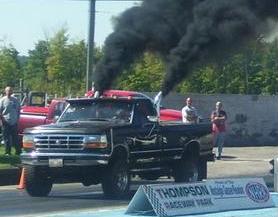Project: Fuel tank vent mod
About one month after I completed the extraction and re-installation of the PSD from my truck, necessitated to replace a rusted out oil pan, I noticed diesel fuel on the floor of my garage under the rear of my truck. Sure enough the steel rear fuel tank had also rusted through. Why in the world Ford ever put a poly midship tank in, and a STEEL rear tank, I'll never figure out. So, I contacted Mike at MTS Company, www.mtscompany.com, and ordered a replacement poly rear fuel tank. I figured that since I would have the tank off of the truck, I might as well do the Fuel Tank Vent Mod that has been talked about in the '94-'97 TDS.com forums. I grabbed the digital camera and went to work.
Overview of Project
Ford installed a roll-over valve on the top of the fuel tanks that has a small 1/4" rubber hose that has a vented cap and is clipped to the frame. The roll-over valve's purpose is to prevent fuel from escaping out of the vent in case the vehicle rolls over. There is also a rubber hose inside of the filler neck that the fuel actually goes through to get into the fuel tank. The steel filler neck and rubber hose you see by crawling under the truck are merely channeling air between them and the internal rubber hose to let air escape from the tank as it is being filled with fuel. This system can definitely be improved upon. The Fuel Tank Vent Mod uses the roll-over valve attached to a larger diameter fuel line that runs from the fuel tank to a fitting installed on the steel filler neck. This assists in evacuating air from the tank during re-fueling. The fuel cap is designed to vent naturally, so there should not be a pressure problem within the tank. The fuel line connecting the tank to the filler neck will contain any fuel should there be a roll-over situation. The installation of the new Ford roll-over valves and the modification of the steel filler necks are exactly the same on the front and rear, so what I have described below applies to both. Just getting access to the top of the tanks to do the work is different.
Materials Used
1) Approximately 7 1/2' of 5/8" fuel line. I used 3' for the front vent, and 4 1/2' for the rear vent. I obtained my fuel line from NAPA, #H-183, for $17 including 4 hose clamps, #705-1313. 2) 2 - Brass hose barbs, Watts AB #A-493, $1.77 each, with 5/8" barb and 1/2" thread. 3) 2 - Ford roll-over valves, #F4TZ-9B593-H, $12.99 each, plus shipping. 4) 2 - Ford valve grommets, #F6TZ-9B076-AA, $3.99 each, plus shipping. You can probably use the existing grommets as I saw no difference when compared to the new ones. 5) Fresh pack of JB Weld, $3.97. Total cost of project is about $65.
Modifying the steel filler neck
Unscrew the three 7 mm hex head screws holding the filler neck to the bed, located around the fuel filler cap. Unscrew the two hose clamps where the steel filler neck meets the rubber neck, and gently pull the steel neck out away from the rubber neck. In doing so, you are also removing a long rubber hose that is attached to the inside of the steel filler neck, that goes through the rubber filler tube into the tank. Keep pulling as it's longer than you'd expect. You will be removing and discarding the rubber hose and internal steel fitting in the following procedure:
Installing the new Ford roll-over valves
The front valve is really easy to do. Stick your head up under the bed in front of the driver's side rear tire and look at the top of the tank. You will see where the fuel lines go into the tank and rearward of that is the grossly inadequate roll over valve/vent with a small rubber tube that is clipped to the frame rail. You should be able just to reach in there and wiggle the valve out of the rubber grommet, and unclip the rubber hose from the frame rail. The rear vent will require dropping the tank to get at it. I would recommend removing the tank completely, install the new vent tube onto the tank, then re-install the tank, rather than try to struggle with the tank hanging there. To do the rear tank, remove the spare tire, remove 1/2 of the skid/mounting plate, place a jack under the exposed half of the tank, then remove the other plate. It helps to have an assistant, but it's do-able by yourself with the proper equipment.
Results
I was a little peeved after completing the project because there was a leak around the sending unit on the tank, and when I filled it up, I had diesel fuel pouring out the top of the tank. So I needed to pull the tank and re-seal the gasket on the sending unit. Anyway, I went to the 'Big Truck' pump to fill up and was totally NOT impressed. It actually seemed like it took longer to fill up as the nozzle kept clicking off. However, I still have to use the 'Little Truck' pump for the real test since the fuel coming out of the 'Big Truck' pump just gushes out. All in all, I'd do this mod again as it's not really that difficult, and didn't cost that much. I found out, through other posts online that you should not use the 90 degree street elbow on the filler neck, only the hose barb. What was happening was the fuel line would dip, creating a trap and collecting fuel and no air at all was getting into the tank. After eliminating the 90 degree street elbows the system works great! I am pleased. Happy wrenching.
|








